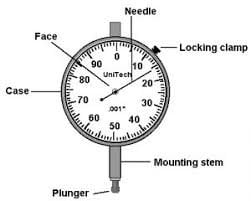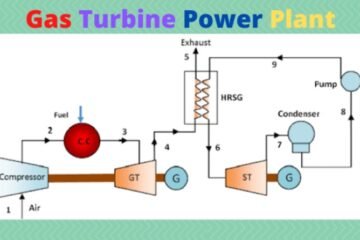What is electric arc furnace
An electric arc furnace (EAF) is a type of industrial furnace used for melting metals, particularly steel and iron, through the use of an electric arc. It’s a crucial tool in the steelmaking industry and is known for its efficiency and flexibility in producing various steel grades.

parts of electric arc furnace
An electric arc furnace (EAF) is a complex industrial furnace with several key parts and components that work together to melt and refine metals. Here are the main parts of an electric arc furnace:
- Shell: The shell is the outer structure of the EAF, typically made of steel and lined with refractory materials. It provides structural support and helps contain the heat and materials inside the furnace.
- Lid or Roof: The lid, also known as the roof, is the top cover of the furnace. It can be lifted or rotated to allow for charging of raw materials and removal of molten metal and slag. It also contains openings for electrodes and various ports for operations like oxygen injection.
- Electrodes: Electrodes are typically made of graphite or other conductive materials and are inserted through openings in the roof. They create an electric arc when electricity is passed through them, generating the high temperatures needed for melting metals.
- Furnace Hearth: The hearth is the bottom portion of the furnace, where molten metal collects. It is lined with refractory materials that can withstand the extreme heat of the molten metal.
- Refractory Lining: The refractory lining is a layer of heat-resistant materials that line the inside of the furnace, including the walls, roof, and hearth. These materials protect the steel shell from the intense heat generated during the melting process.
- Electrode Holders: Electrode holders secure the electrodes in place and allow for adjustments to control the position of the electric arc.
- Transformer: Electric arc furnaces require a high voltage electrical supply to generate the electric arcs. A transformer is used to step up the voltage from the power source to the level needed for the EAF operation.
- Electrical System: The electrical system includes components such as transformers, circuit breakers, switches, and control panels to manage the flow of electricity to the electrodes and other furnace systems.
- Cooling System: EAFs generate a tremendous amount of heat, and a cooling system is essential to prevent overheating and maintain the integrity of the furnace components. Water-cooled panels, pipes, and cooling jackets are commonly used for this purpose.
- Gas Injection System: Some EAFs are equipped with a gas injection system that introduces gases like oxygen or argon into the furnace. These gases can affect the melting process and help in refining the metal.
- Dust and Fume Collection System: EAF operations can generate dust and fumes, which need to be collected and filtered to reduce environmental impact and protect worker health.
- Tapping System: A tapping system includes equipment such as a tap hole, tap spout, and ladle, which are used to safely remove molten metal and slag from the furnace for further processing or casting.
- Control and Automation System: Modern EAFs are often equipped with sophisticated control and automation systems that monitor and regulate various parameters, such as temperature, electrode position, and power input, to ensure efficient and precise melting.
These are the primary components of an electric arc furnace, and their design and operation can vary depending on the specific requirements of the metal production process and the type of materials being melted and refined.
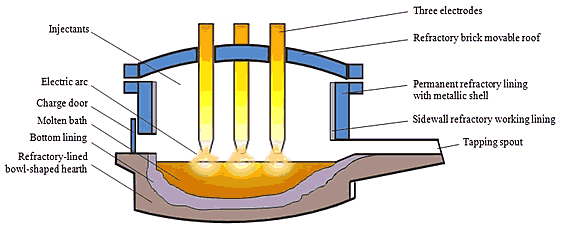
Electric arc furnace process
The electric arc furnace (EAF) process is a step-by-step method used in the melting and refining of metals, particularly steel. Here’s a simplified step-by-step description of how an EAF typically operates:
- Charging: The process begins by loading the raw materials into the EAF. These materials can include scrap steel, iron ore, alloying elements, and fluxes. The materials are typically charged from the top of the furnace through an opening in the roof or lid.
- Electrode Placement: Electrodes, usually made of graphite, are positioned in the furnace roof’s electrode holders. These electrodes will create an electric arc, generating the intense heat needed for melting the materials.
- Start-Up: The EAF is energized, and electrical power is supplied to the electrodes. When the electrodes touch the materials in the furnace, an electric arc is established between the electrodes and the charge materials, initiating the melting process.
- Melting: The electric arc generates extremely high temperatures, often exceeding 3,000 degrees Celsius (5,432 degrees Fahrenheit). This intense heat melts the materials in the furnace, including the scrap steel and any other added components like alloys.
- Oxygen Injection (Optional): In some cases, oxygen or other gases can be injected into the furnace to accelerate the combustion of impurities, aid in chemical reactions, and enhance the melting process. This step is optional and depends on the specific steelmaking process.
- Chemical Reactions: As the materials melt, chemical reactions occur within the furnace. Impurities in the scrap steel are oxidized and removed as slag, while alloying elements are added to achieve the desired steel composition.
- Temperature Control: The EAF’s control system continuously monitors and adjusts the electric arc’s power and position to maintain the desired temperature and composition of the molten metal.
- Sampling and Analysis: Samples of the molten metal are periodically taken to assess its chemical composition and temperature. This information helps operators make necessary adjustments to meet quality standards.
- Refining: Depending on the steel grade being produced, additional refining steps may be performed. These can include adding fluxes or alloying materials to achieve specific metallurgical properties.
- Tapping: When the molten metal has reached the desired composition and temperature, a tap hole in the bottom of the furnace is opened, allowing the molten steel to flow into a ladle or casting vessel. Simultaneously, slag is also removed from the furnace.
- Ladle Transfer: The molten steel is transferred from the EAF to a ladle for further processing. It may be transported to a secondary refining process, such as a ladle furnace, to further refine the steel’s composition and temperature.
- Casting: The refined molten steel is cast into various shapes, such as slabs, billets, or ingots, depending on the intended use. The casting process can vary depending on the specific steel product being produced.
- Cooling and Solidification: The cast steel is allowed to cool and solidify, forming the final product. The cooling process can be controlled to achieve specific microstructures and mechanical properties.
- Quality Control: The finished steel products are subjected to quality control measures to ensure they meet the required standards and specifications.
The EAF process offers flexibility, efficiency, and control in steelmaking, making it a preferred method for producing a wide range of steel products while also recycling scrap metal. The specific steps and details of the process can vary depending on the type of steel being produced and the equipment used in the EAF.
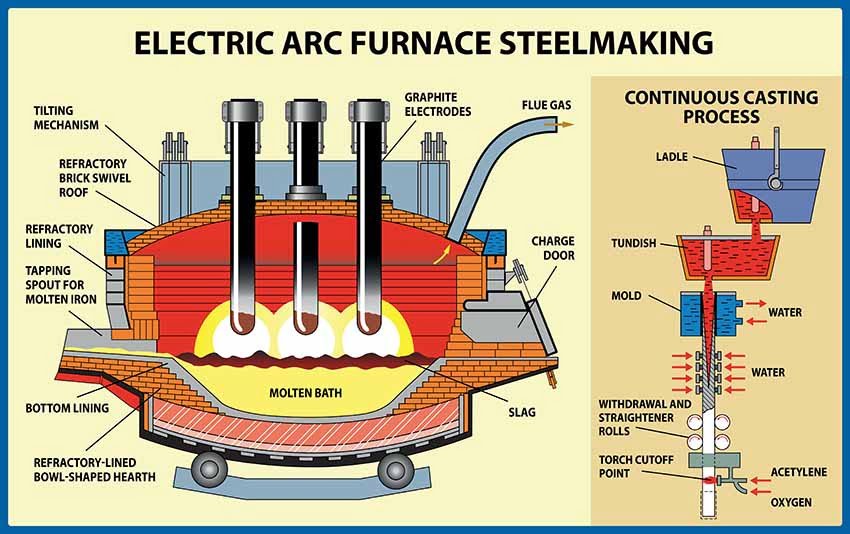
Application of electric arc furnace
Electric arc furnaces (EAFs) have a wide range of applications, primarily in the metallurgical and manufacturing industries. Here are some key applications of electric arc furnaces:
- Steel Production: EAFs are commonly used for steelmaking. They melt scrap steel, iron ore, and various alloying elements to produce different grades of steel. This process is essential for manufacturing a wide range of steel products, including construction materials, automotive components, and machinery parts.
- Stainless Steel Production: EAFs are crucial for producing stainless steel, which is highly resistant to corrosion and heat. The EAF process allows for precise control over the composition of stainless steel, making it suitable for various applications in the chemical, food processing, and medical industries.
- Ferroalloy Production: Electric arc furnaces are used to produce ferroalloys, which are alloys of iron with other elements like silicon, manganese, or chromium. Ferroalloys are essential for enhancing the properties of steel and manufacturing specialized alloys used in various industries.
- Cast Iron Production: Some EAFs are designed for producing cast iron, which is used in the production of pipes, fittings, engine blocks, and other heavy-duty applications.
- Non-Ferrous Metal Production: While EAFs are most commonly associated with steel and iron production, they can also be used to melt and refine non-ferrous metals like copper, aluminum, and nickel. This is important for recycling and refining these metals.
- Recycling: EAFs play a critical role in recycling scrap metal. They can quickly melt down and refine various types of scrap, reducing the environmental impact of metal production and conserving natural resources.
- Specialty Alloys: Electric arc furnaces are used to create specialty alloys with precise chemical compositions. These alloys find applications in aerospace, electronics, and other high-tech industries.
- Heat Treatment: In addition to melting metals, EAFs can be used for heat treatment processes, such as annealing or tempering, to improve the mechanical properties of steel and other materials.
- Research and Development: EAFs are used in research and development settings to experiment with new alloy compositions and refine manufacturing processes.
- Environmental Remediation: In some cases, EAFs are employed for the decontamination and treatment of hazardous waste materials, helping to neutralize pollutants and reduce their environmental impact.
Electric arc furnaces are versatile and efficient tools in the manufacturing world, and their applications continue to expand as technology advances and industries seek more sustainable and cost-effective ways to produce metals and alloys.
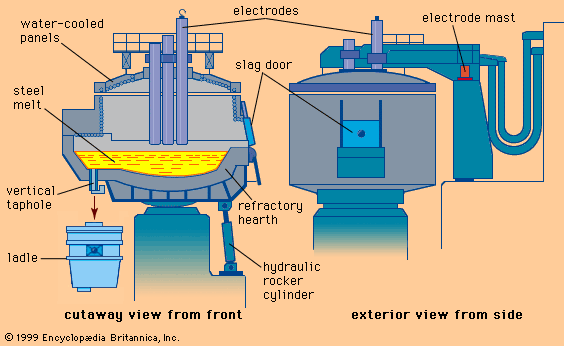
Advantages of electric arc furnace
Electric arc furnaces (EAFs) offer several advantages in various industrial applications, making them a popular choice for melting and refining metals. Here are some of the key advantages of using electric arc furnaces:
- Energy Efficiency: EAFs are generally more energy-efficient than other types of furnaces, such as blast furnaces. They can quickly reach and maintain high temperatures, reducing energy consumption and costs.
- Flexibility: EAFs can easily switch between different types of raw materials, including scrap metal, iron ore, and alloys. This flexibility allows manufacturers to adapt to changing market demands and recycle scrap materials effectively.
- Environmental Benefits: EAFs emit fewer greenhouse gases and pollutants compared to traditional steelmaking methods like blast furnaces. This contributes to lower carbon emissions and improved air quality.
- Lower Capital Costs: Building and maintaining EAFs tend to be more cost-effective than constructing and operating blast furnaces, which are larger and more complex facilities.
- Quick Start-Up and Shutdown: EAFs can be started and stopped quickly, making them ideal for handling fluctuating production demands and reducing downtime.
- Precise Temperature Control: Electric arc furnaces offer precise temperature control, which is crucial for achieving specific metallurgical properties and producing high-quality alloys.
- Custom Alloy Production: EAFs allow for the production of custom alloys with precise chemical compositions, catering to the needs of various industries.
- Recycling Capabilities: EAFs are excellent for recycling scrap metal, reducing the environmental impact of metal production and conserving natural resources.
- Reduced Waste: The EAF process generates less waste material compared to other melting and refining methods, reducing disposal costs and environmental impact.
- Lower Noise Levels: Electric arc furnaces typically produce less noise compared to some other industrial processes, creating a safer and more comfortable working environment for operators.
- Improved Safety: EAFs have safety features that help prevent accidents and protect workers from exposure to extreme heat and harmful substances.
- Modularity: EAFs can be designed in various sizes and configurations, allowing companies to scale their operations up or down as needed.
- High Product Quality: With precise control over temperature and composition, EAFs can consistently produce high-quality metals and alloys, meeting stringent industry standards.
- Reduced Lead Times: EAFs can significantly reduce lead times in metal production because of their quick start-up and operational flexibility.
- Lower Maintenance Costs: Electric arc furnaces generally have lower maintenance requirements compared to some other types of furnaces, which can lead to cost savings over time.
These advantages make electric arc furnaces a preferred choice for a wide range of applications in the metallurgical and manufacturing industries, including steelmaking, alloy production, and metal recycling. Additionally, their energy efficiency and reduced environmental impact align with sustainability goals and regulatory requirements.
Disadvantages of electric arc furnace
While electric arc furnaces (EAFs) offer many advantages, they also have some disadvantages and limitations that need to be considered in industrial applications. Here are some of the key disadvantages of using electric arc furnaces:
- High Electricity Consumption: EAFs require a substantial amount of electrical power to generate the electric arc and maintain high temperatures. This can result in significant electricity costs, especially during periods of high energy prices.
- Initial Investment Costs: The capital cost of installing an EAF can be high, particularly for larger furnaces with advanced features and pollution control equipment. This initial investment can be a barrier for smaller companies or those with limited resources.
- Limited Capacity: EAFs have a limited capacity compared to some other types of furnaces like blast furnaces. This limitation can be a constraint for companies with high production demands.
- Variable Scrap Quality: When using scrap metal as a raw material, the quality and composition of the scrap can vary, which can lead to variations in the final product’s quality and composition.
- Dust and Emissions: EAFs can generate dust and emissions, including particulate matter and volatile organic compounds. To address environmental concerns, additional equipment and processes may be needed for emissions control and dust collection.
- Consumable Electrodes: The electrodes used in EAFs are consumable and need to be replaced periodically. This incurs additional maintenance and operating costs.
- Maintenance Requirements: While EAFs generally have lower maintenance requirements compared to some other furnace types, they still require regular maintenance to ensure optimal performance and longevity.
- Noise and Vibration: EAFs can produce noise and vibration during operation, which may require measures to protect workers and minimize the impact on nearby communities.
- Reliability: The electrical components of EAFs, such as transformers and power supplies, can be susceptible to malfunctions or breakdowns, leading to production disruptions.
- Safety Concerns: Working with high temperatures and electrical currents poses inherent safety risks. Proper safety measures and training are essential to prevent accidents.
- Specialized Expertise: Operating and maintaining EAFs requires specialized knowledge and expertise, which can limit the pool of qualified personnel and increase labor costs.
- Raw Material Handling: EAFs rely on a steady supply of raw materials, which must be properly sorted, prepared, and loaded into the furnace. Inconsistent or inefficient material handling can affect production efficiency.
- Environmental Regulations: Meeting stringent environmental regulations, especially regarding emissions and waste management, can add complexity and cost to EAF operations.
- Production Interruptions: EAFs may need to be shut down for maintenance or electrode replacement, leading to temporary production interruptions.
- Size Limitations: The physical size and design of EAFs can limit their application in some industries or for specific products that require larger or differently shaped furnaces.
Despite these disadvantages, electric arc furnaces remain a valuable and widely used tool in the metallurgical and manufacturing industries, especially when their advantages, such as flexibility and environmental benefits, align with specific production requirements and objectives. Advances in technology continue to address some of these limitations over time.
blast furnace vs electric arc furnace
Here’s a comparison table between a blast furnace and an electric arc furnace (EAF) based on various key aspects:
| Aspect | Blast Furnace | Electric Arc Furnace (EAF) |
|---|---|---|
| Primary Use | Production of primary iron from iron ore | Melting and refining of scrap metal and alloys |
| Raw Materials | Iron ore, coke, limestone, and additives | Scrap metal, ore, alloys, and additives |
| Energy Source | Coke and coal for heating | Electricity for generating electric arcs |
| Temperature | Extremely high temperatures (above 2,000°C) | Very high temperatures (above 3,000°C) |
| Environmental Impact | High greenhouse gas emissions | Lower greenhouse gas emissions |
| Efficiency | Lower energy efficiency | Higher energy efficiency |
| Flexibility | Limited flexibility in raw material use | Greater flexibility with scrap metal |
| Production Scale | Typically large-scale operations | Suitable for both large and small-scale operations |
| Start-Up Time | Longer start-up time (days) | Shorter start-up time (hours) |
| Continuous Operation | Often continuous operation | Easily adaptable to fluctuating demand |
| Quality Control | Limited control over composition | Precise control over composition and temperature |
| Maintenance | High maintenance due to wear and tear | Lower maintenance requirements |
| Initial Investment | High capital investment | Varies based on size and capacity |
| Recycling | Not suitable for recycling scrap metal | Ideal for recycling scrap metal |
| End Products | Pig iron, which requires further processing | Molten metal for various applications |
| Environmental Benefits | Lower air pollution, but high CO2 emissions | Lower air pollution, reduced CO2 emissions, and energy efficiency benefits |
Please note that the comparison is based on general characteristics, and specific operations and results can vary depending on the design and technology used in individual blast furnaces and EAFs. The choice between these two methods depends on factors like the type of metal production, raw materials available, and environmental considerations.
Check Out Other Important Topics
| IC Engine | Important PDFs | Boilers | Synergy Maritime Exam | Naval Arch | MEO Class 4 |
| Interview Questions | Difference Between | Types of Pumps | Auxiliary Machines | Types of Valves | Home |

